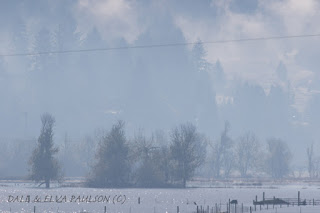 |
| Anna's Hummingird |
Winter in western Oregon is pretty mild compared to where I
grew up – Wisconsin. I lived in a drafty
pre-Civil War farmhouse which was heated with wood stoves. If we wanted to leave the house overnight
during the winter, all things that shouldn’t be frozen were stored in a small
closet with a light on for warmth.
 |
| The pumproom at my family home. Many a time I washed my hair under its cold, cold water. |
When it got colder than 20 degrees below zero we quit pumping water for fear the pump would freeze. I should clarify the pump was one of those old iron pumps with a long handle. It was an awful chore to unfreeze the pump. When it was really cold my mother was known to dump a shovel-full of snow on the wood floors and sweep like mad. She likeed how much cleaner the floor got with her ‘sweeping compound.’ Of course the main rooms were reasonably warm, but the floors had no insulation.
Oregon is an odd state in that the coast and the western
valleys have hardly, if any snow each winter; but up at
Crater Lake average snowfall is almost 44 feet!
The Cascade Mountains have some of the best skiing in the nation.
But my little Anna’s hummingbird may think western Oregon
winters are plenty cold. We finally got
a few days of snow just after the new year started. I was out at first light, ready to hang his
hummingbird feeder. The hummer was busy
buzzing about in my hawthorn, trying to find a branch that wasn’t drenched in
snow! It does look odd, doesn’t it, i.e.
a hummingbird surrounded by snow. Soon
the arriving chickadees and juncos shook much of the snow free and he could perch
and fluff up between his forays to the feeder.
Fortunately the snow only lasted a couple of days.
Winter in western Oregon also brings rain, lots of
rain. This year we are getting even more
than usual. This big ‘winter lake’ is
about 40 miles west of where I live.
Most of the year this huge lake is a lovely green valley dotted with fat
cows. Fortunately the ranchers know that
their land will probably spend part of the winter underwater. Their homes are above high water and they make sure they have high land for their livestock. The floodwaters bring valuable nutrients to
the land and so their pastureland remains rich.
As soon as temperatures drop farther to the north, hundreds
of ducks and geese come to rest and feed on the flooded pasturelands. The water is shallow and just underneath lush
grass awaits them. Nearly every time we
drive by this winter lake we spot at least one pair of bald eagles. Winter is a rich feeding time for them
too.
Another sign winter in my life is a good dose of whale
watching. During late December and early
January about 18,000 gray whales swim south along Oregon’s coast heading Baja,
Mexico where they birth. Often the
whales are hard to spot. Either they are
swimming too far from the coast or the sea is rough and full of whitecaps. Last Saturday was the perfect day; clear skies and a low swell gently rolling
towards shore. We parked to eat lunch
and watch, hoping to see a whale to two.
I immediately spotted four spouts, and then two more . . . and
more. We’ve never had such good whale
watching. Over the span of an hour we saw at least twenty whales.
Most were in groups of two, three, and sometimes four. Usually a group swims along the surface
spouting frequently, then, one after another, they dive and remain out of sight
for a few minutes. They’ll reappear a
little farther south. When I see the
tails go up in the air, I know they are diving deep and it is time to look for
another group. I just wish they swam
closer to shore. Often all I can see was
their white puff of air exhaling.
Sometimes I see their backs for a moment or two. The best is their big tail, rising up
and slipping into the water.







Dear Elva, thank you for a wonderful post full of lovely pictures. I wonder if grey whales come to Sydney. Cheers, Sadami
ReplyDeleteHi Sadami ....Grey whales are now considered to be a northern hemisphere species. At one time they inhabited more of the earth than they do now. I don't know if they ever got as far south as Sydney.
DeletePoor little hummies! Good thing they have special humans looking out for them. Some just don't want to migrate. Beautiful winter painting, too. Certainly no mild winter. Enjoyed your account of the whales, too.
ReplyDeleteWonderful post! I have never been to Oregon, so I especially appreciate your description and sketches of what winter is like there.
ReplyDeleteYour sketches and stories are a balm for the winter woes.
ReplyDeleteLove the hummer! I have 2 chattering outside at my feeder in Vancouver, BC. Your paintings and sketches are beautiful.
ReplyDeleteLove the hummer in the snow. We are lucky to have them stick around all winter. Good thing we don't get that cold very often. Fun post.
ReplyDeleteI go by your old homestead every now and again as it's near my sisters place. I remember your mom and dad. I would see them uptown running errands. I heard her speak at school. I have been in the old home when Deanne stayed there. The home is still there but uninhabitable. When I go by I always think about your parents and how they loved nature. I see you do to.
ReplyDeleteThank you for the nice note. I was so fortunate to grow up in that old house.
Delete